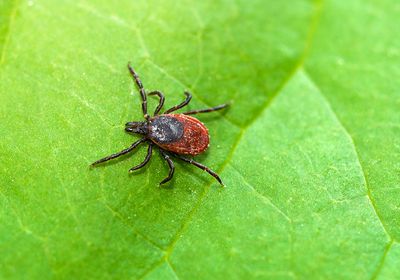ABOVE: The Crimean Congo virus is a tickborne pathogen that can cause severe illness and death. ©ISTOCK, Avalon_Studio
Ticks are tiny creatures that can stick their pincers into humans and pass on some nasty disease-causing viruses, including the Crimean Congo virus. This pathogen causes an illness that starts out like the flu, but can ultimately lead to severe bleeding, liver damage, and death in 10 to 40 percent of cases.1 With the onslaught of climate change, tickborne viruses are rapidly spreading around the world.2 The premise of the Crimean Congo virus dispersing across several countries was enough to spur Vanessa Monteil, a biologist in the group of virologist Ali Mirazimi at the Karolinska Institute, into action.
Previously, the mechanism by which Crimean Congo virus entered human cells was relatively unknown. In a study recently published in Nature Microbiology, Monteil and her colleagues found that the virus binds to the low density lipoprotein receptor (LDLR), which sequesters cholesterol inside the cell, to make its entry.3 These results could be useful for developing vaccines or other therapies against the virus.
Monteil and her colleagues first investigated where the virus might attach to cells. To do that, the researchers randomly mutated single amino acids in rodent haploid cells and then exposed these cells to the Crimean Congo virus. “Cells that survive will have some mutation in genes coding for proteins that are important for the virus to enter,” said Monteil. By picking out the surviving cells and sequencing them, the team found that all the cells contained mutations in the LDLR gene, indicating that the receptor was probably important for viral entry.
The scientists next used CRISPR-Cas9 to knock out LDLR in several cell lines (including a human line) and found that there was a significant reduction in viral infection in comparison to unedited controls. Likewise, when they used the same technique to knock out LDLR in human blood organoids, little collections of capillary-like structures derived from stem cells, they found a similar reduction in infection when Crimean Congo virus was added. This indicated that in human blood vessels, LDLR probably played an important role in allowing the virus to enter the vasculature.
Given these results, the team tested if the virus would bind directly to the LDLR protein. By adding soluble LDLR protein to the cells—a strategy akin to using a “molecular decoy,” a distraction for the virus to bind to instead of the cell—the researchers blocked the virus from infecting the cells, with increasing concentrations of LDLR protein providing more protection.
Next, they turned their attention to the virus and determined which viral proteins were involved in its binding to the receptor. They inserted a fluorescent reporter to the LDLR gene in human cells, then added candidate viral proteins to the cell culture. The team was particularly curious to see if two Crimean Congo virus glycoproteins (Gc and Gn) would mediate the virus-receptor interaction.
They found that Gc directly bound to LDLR, but Gn did not. However, when Gc and Gn were added together, there was a synergistic effect on binding. “When we put the Gn with Gc, we increase the affinity of Gc for the receptor,” said Monteil.
The study results complement findings published earlier this year in Cell Research, which also implicated LDLR as an entry receptor for the pathogen.4 “Today, we can say that LDLR is really a receptor for Crimean Congo [virus],” Monteil said. She believes that their work adds some clarity into the additional proteins and mechanism by which this viral entry occurs.
For Dennis Bente, a microbiologist at the University of Texas Medical Branch who was not involved in the research, the collective synchrony of these two papers is exciting for the field at large—especially because Crimean Congo virus requires extreme biocontainment measures and is difficult to study. “It’s a key finding in the molecular virology of the virus,” he said. Bente noted, though, that LDLR is probably not the only way the virus can enter the cells, and more work is needed to better map out all the ways Crimean Congo virus can infect someone.
In the meantime, Monteil is excited to extend these findings toward therapeutic development. She hopes to design proteins that can bind to the virus itself, but not interfere with the body’s cholesterol-sequestering mechanism—since completely blocking LDLR would likely disturb critical metabolic functions.
“Maybe even one day this can be used as a treatment to save people, and to help them avoid reaching the level of severe disease," she said.
- Hawman DW, Feldmann H. Crimean–Congo haemorrhagic fever virus. Nat Rev Microbiol. 2023;21(7):463-477.
- CDC. Climate and infectious diseases. Centers for Disease Control and Prevention. Last Reviewed August 2, 2022. Accessed May 1, 2024.
- Monteil VM, et al. Crimean–Congo haemorrhagic fever virus uses LDLR to bind and enter host cells. Nat Microbiol. 2024;9:1499-1512
- Xu ZS, et al. LDLR is an entry receptor for Crimean-Congo hemorrhagic fever virus. Cell Res. 2024;34(2):140-150.




